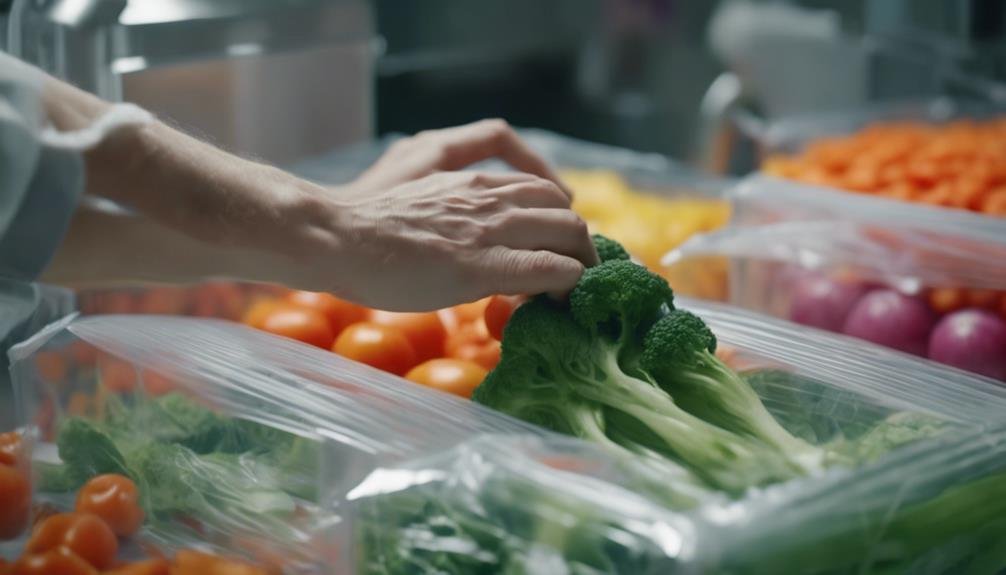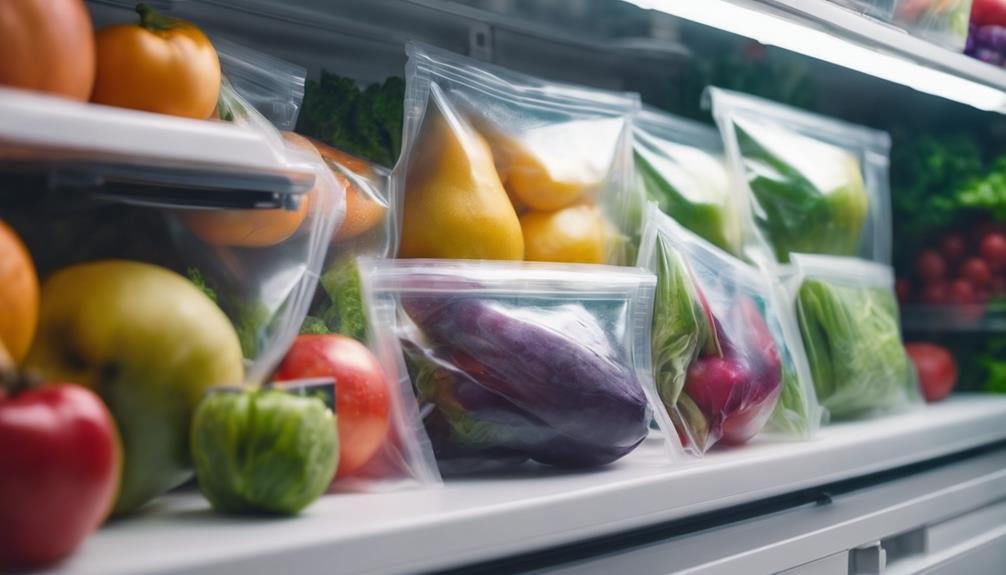Vacuum sealing is an excellent way to preserve nutrients in your food. It retains 3-5 times more nutrients than traditional storage methods by creating an airtight seal that protects against oxidation. This process preserves the natural color, flavor, and texture of your food while extending its shelf life. You'll find it especially effective for fruits, vegetables, lean meats, herbs, and spices. To get started, choose a vacuum sealer with adjustable settings and a wide sealing strip. Clean and dry your produce, portion your food, and seal it in appropriate bags or containers. By following proper storage guidelines, you'll maximize nutrient retention and reduce food waste. Discover how this simple technique can revolutionize your food preservation routine.
Benefits of Vacuum Sealing
Vacuum sealing consistently offers a range of benefits that'll help you preserve the nutritional value of your food for longer periods. This innovative food preservation method can retain up to 3-5 times more nutrients compared to traditional storage techniques. By creating an airtight seal, vacuum sealing protects your food from oxidation, which is a primary cause of nutrient loss.
One of the key benefits of vacuum sealing is its ability to maintain the natural color, flavor, and texture of your food. This means you're not only preserving nutrients but also guaranteeing that your meals remain appetizing. Additionally, by extending its shelf life, vacuum sealing reduces the need for added preservatives, which can negatively impact nutrient content.
You'll be pleased to know that studies have shown vacuum sealing's effectiveness in preserving essential vitamins and minerals. This can contribute to a healthier diet overall.
Choosing the Right Equipment
When you're in the market for a food-saver, it's important to choose equipment that'll meet your specific preservation needs. Vacuum sealers come with various features, and selecting the right one can make a significant difference in preserving your food's nutrients and quality.
For those who frequently seal fruits and vegetables, look for a vacuum sealer with adjustable settings and a pulse function. These features allow you to control the suction power, preventing delicate produce from being crushed in the vacuum bag. Additionally, a moist setting is vital if you plan to seal foods with higher liquid content, ensuring a proper seal without compromising the food's integrity.
To guarantee airtight seals, opt for a vacuum sealer with a wide sealing strip. This feature helps maintain the freshness of your preserved items for extended periods.
Don't forget to take into account a model with an accessory port, which enables you to seal containers and jars, expanding your preservation options beyond vacuum bags.
Step-by-Step Sealing Process

To get started with preserving your food's nutrients, you'll want to follow a straightforward step-by-step sealing process. Begin by selecting fresh, high-quality food items for vacuum sealing. Clean and dry the food thoroughly to prevent moisture from compromising the seal. Next, portion your food into appropriate sizes for your needs and place them in vacuum-safe bags or containers.
When using a vacuum sealer, position the open end of the bag into the sealer's chamber. Make sure the bag is smooth and free of wrinkles to create an airtight seal. Activate the vacuum sealer, which will remove the air from the bag and create a tight seal around the food. Once sealed, inspect the package for any leaks or imperfections.
Label your vacuum sealed food with the contents and date for easy identification. Store the sealed packages in the refrigerator or freezer, depending on the food type and your intended storage duration.
Best Foods for Vacuum Sealing
Now that you've mastered the sealing process, let's explore which foods are best suited for this nutrient-preserving technique. Vacuum sealing is particularly effective for foods rich in vitamins and minerals that are prone to nutrient loss during storage. By removing air and creating an airtight seal, you'll greatly extend the shelf life of these foods while maintaining their nutritional value.
Here are some of the best foods for vacuum sealing:
- Fruits and vegetables: Superfoods like kale, spinach, and berries are ideal candidates.
- Lean meats: Preserve the protein content and prevent freezer burn.
- Herbs and spices: Lock in their potency and flavor for longer periods.
- Whole grains, nuts, and seeds: Maintain their nutrient profile and prevent rancidity.
When you vacuum seal these foods, you're not just extending their shelf life but also preserving their essential nutrients. This method is especially beneficial for delicate produce and herbs that can quickly lose their nutritional value when exposed to air.
Storage and Shelf Life

Understanding proper storage techniques and shelf life is crucial for maximizing the nutrient-preserving benefits of vacuum sealing. When you vacuum seal foods, you're creating an airtight environment that greatly extends their shelf life. This process helps retain essential vitamins, minerals, and antioxidants that would otherwise degrade over time due to oxidation.
To make the most of your vacuum-sealed foods, store them in a cool, dark place away from direct sunlight. Refrigeration or freezing can further prolong the shelf life of sealed items. Remember that while vacuum sealing dramatically increases storage time, it doesn't make food last indefinitely. Keep track of when you sealed each item and use it within the recommended timeframe for best results.
Different foods have varying shelf lives even when vacuum sealed. For example, fruits and vegetables may last 1-2 weeks in the fridge, while meats can be stored for 6-12 months in the freezer. By understanding these storage guidelines, you'll make sure that you're consuming your vacuum-sealed foods at their peak nutritional value.
This approach not only preserves nutrients but also reduces food waste and saves you money in the long run.
Tips for Optimal Results
Several key tips can help you achieve the best results when vacuum sealing to preserve nutrients in your food.
First, make sure your produce is clean and dry before sealing, as excess moisture can compromise the seal and promote bacterial growth.
When vacuum sealing green beans or other vegetables, blanch them briefly to halt enzyme activity and maintain color and texture.
For top nutrient retention, follow these tips to keep your vacuum-sealed foods at their best:
- Store sealed items in a cool, dark place to minimize light exposure and temperature fluctuations.
- Label packages with contents and date to track freshness and rotate stock.
- Use appropriate vacuum sealing bags designed for long-term storage or sous vide cooking.
- Remove air gradually to prevent crushing delicate foods and maintain their structure.
When preparing vacuum-sealed foods, consider sous vide cooking methods, which can help preserve nutrients by cooking at precise temperatures.
Remember that while vacuum sealing extends shelf life, it doesn't indefinitely preserve food. Regularly inspect sealed items for signs of spoilage and use them within recommended timeframes to ensure you're consuming nutrient-rich foods at their peak quality.
Conclusion
You've now discovered the secret to preserving your food's nutritional value like a time capsule. With vacuum sealing, you'll keep your meals fresher for longer and reduce waste.
Remember to choose the right equipment, follow the proper sealing process, and select suitable foods for best results. By implementing these tips, you'll become a master of food preservation, ensuring your pantry is always stocked with nutrient-rich options.
Don't let your food's potential go to waste!
